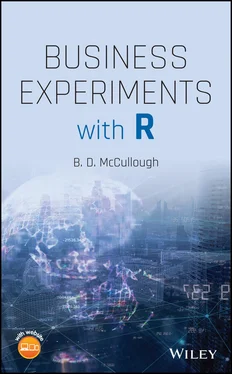1 ...8 9 10 12 13 14 ...18 Regardless of the true mechanism, if treatment and control had been assigned randomly, then the effects of the lurking variable would have been spread out between the two groups instead of having too many consenters in the experimental group. Thus, randomization protects against the effect of lurking variables, even when we don't know what variables we need protection against! Remember, lurking variables are not to be confused with confounding variables; again, see the “Learning More” section for details on this point.
A postscript to the experiments is in order. The success of the trials was formally announced in 1955, and widespread vaccination began. However, a problem with the injectable vaccine quickly arose. There were six different manufacturers of the vaccine, and not all of them followed Salk's instructions for preparing the vaccine. Hundreds of cases of paralysis were reported, including cases when the paralysis began in the arm that received the injection! The program was suspended in 1955. In 1960 an even better oral vaccine was introduced and put into widespread use. This is why, when examining the data, you might not see a large drop after 1955.
1 1.3.1 List the problems with the first Salk trial.
2 1.3.2 How did the second Salk trial overcome the problems in the first Salk trial?
3 1.3.3 Why were the sample sizes so large for the Salk trials?
4 1.3.4 Find an example of another failed medical experiment. Be sure to articulate why it failed.
5 1.3.5 Plot the number of cases of polio in the United States by year; the data are in polio.csv . The eradication of polio is obvious as time increases. What is noticeable about the period before the introduction of the polio vaccine?
1.4 What Is a Business Experiment?
We have seen that when using observational data to answer a business question, the answer we get can depend on which variables are included in the analysis, how relationships are modeled, and a host of other decisions. These types of analyses are difficult to rely on, easy to argue about, and hard to do well. Consequently, their value for informing business decisions is limited. None of these criticisms apply to business experiments.
Some persons are under the mistaken belief that an experiment is just “trying something” to see “whether or not it works,” and this approach very often leads to unusable results. For example, a large bank wanted to improve its customer service, so it designated some of its branches as “laboratories” where many ideas were implemented. So many things were changed in haphazard fashion across so many branches that it was impossible to determine which of the ideas was responsible for improved results. This was a very expensive “experiment” by one of the major banks, and it produced nothing useful – it was a complete waste of resources.
Sometimes a simple experiment can point the direction toward millions of dollars as happened at Intuit. And this was after a formal usability study gave a decidedly negative recommendation about the idea! As recounted by Thomke (2020, chapter 2),
[An] engineer noticed that about 50 percent of prospective customers tried the company's small business product 20 minutes before they had to make payroll. The problem was that all payroll companies took hours or even days to approve new customers before the first employee could be paid. Wouldn't potential customers be very pleased if they could make payroll before the long approval process was done? To make sure there was a genuine need, the engineer and product manager ran a usability study. The result: none of the twenty participants were interested in a fast payroll solution. But instead of shelving the idea, Intuit modified its webpage within 24 hours and ran a simple experiment that offered two versions of the software – one with the option to click on “pay employees first” and another one with “do set‐up first.” (When users clicked on “pay employees first” option, they got a message that the feature wasn't ready.) Contrary to the usability test results, the experiment revealed that 58 percent of new users picked the faster payroll option. Ultimately, the feature became hugely popular, lifted the software's conversion rate by 14 percent and generated millions of additional revenue.
An experiment is a statistical test by which a hypothesis is subjected to data produced according to a specific procedure in which some variable thought to affect the output is deliberately manipulated. A business experiment is merely an experiment whose purpose is to inform a business decision. By contrast, some disciplines, e.g. medicine, psychology, or biology, develop theories and then use experiments to test the theory; not so for us. Each of these disciplines has its specific theories and subjects, and therefore experimental methods need to be adapted to each discipline. For example, engineers usually have well‐specified physical models, subjects that are often physical entities that respond predictably, and prediction methods that have small errors. In business, well‐specified models are an exception, subjects are often human (who can respond in two different ways to the same stimulus!), and prediction methods have large errors. Therefore, it is usually the case that engineering methods for experimental design will not be applicable in a business setting, and vice versa.
EXAMPLES OF EXPERIMENTS
Example ISlow payment of invoices creates numerous problems for companies, not the least of which is a decrease in cash flow and the attendant need to incur short‐term debt to cover the shortfall. Decreasing customers' payment times has obvious advantages, but how to achieve this goal is not always clear. How long after the customer receives the goods or services should the invoice be sent? If it isn't paid on time, should another invoice be sent? Or a formal letter? Or should would a phone call be more effective? One company had been in the habit of just sending repeat invoices every month and decided to take action. One set of late‐paying customers was sent a formal letter asking for payment of the late debt. Another set of customers was called. The times of these letters and calls were varied across several trials. At the end of the experiment, the conclusion was that a phone call 10 days after the due date was most effective. The overall time from initial billing to final payment was reduced from 110 to 75 days.
Example IIA large, multi‐office financial services corporation wanted to improve the process by which its customers apply for credit. The immediate problem was that 60% of the applications had to be sent back for reprocessing, usually due to incomplete information (e.g. the applicant didn't write down his age or made a transposition error when writing his phone number). Not only is this expensive, but also it greatly adds to the overall processing time, which leads to many potential customers dropping out of the application process entirely. After a brainstorming session, the project team tasked with addressing this problem decided to focus on three variables: the type of application, how detailed are the instructions, and whether examples were provided. Two additional factors thought to affect the reprocessing rate are type of application (loan or lease) and region (Midwest vs. Northeast). Thus five factors with two levels each were used in the experiment (it doesn't matter which one is called level 1 or level 2) are presented in Table 1.5
Table 1.5 Factors and levels for financial services example.
| Factor |
Level 1 |
Level 2 |
| (A) Application type |
Loan |
Lease |
| (B) Region |
Midwest |
Northeast |
| (C) Instructions |
Current instructions |
Instructions with more detail |
| (D) Example |
Current example |
Examples with more detail |
| (E) Negative example |
None (current) |
Example of what not to do |
Only two of the five factors were found to affect the reprocessing rate, C and D. The application form was redesigned, and the completeness rate increased to 95%, virtually eliminating the need for reprocessing. The number of completed applications increased dramatically, since customers were no longer dropping out. All the persons who had been tasked with reprocessing were reassigned to new tasks, increasing productivity without increasing the payroll.
Читать дальше












